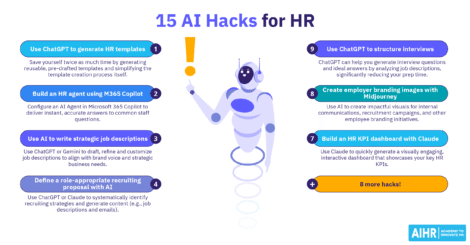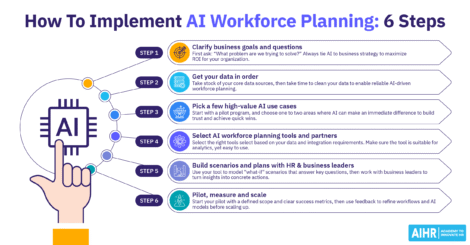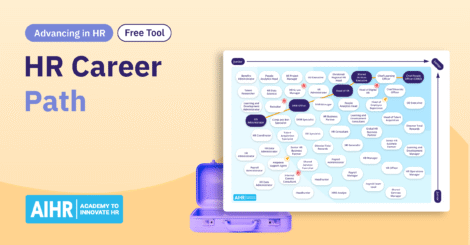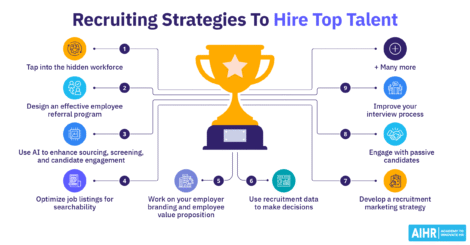75% of organizations rate their ability to accurately evaluate the value individual employees create as barely or not at all effective. Naturally, this opens the door for AI’s potential to make otherwise ineffective performance reviews a valuable tool for employee growth and career development.
This article discusses what AI for performance reviews entails, why it’s helpful, and how you can use it to improve the performance review process at your organization. It also offers a comparison of different relevant AI tools you can use for this purpose.
Want to put AI into practice right away? Download the AI in HR Cheat Sheet Collection to access 10 one-page guides with practical use cases, tool tips, and ready-made prompts, specifically designed to help HR professionals like you make smarter, faster decisions, including around performance reviews.

Contents
What is AI for performance reviews?
Why use AI for performance reviews?
Examples of AI for performance reviews
Top AI tools for performance reviews
5 practical ways to use AI for performance reviews
Key takeaways
- AI in performance reviews uses tools to detect bias, track goals, assess performance, and draft reviews
- It helps reduce subjectivity, improve fairness, and make reviews more efficient and trusted
- HR can choose from many AI tools, ranging from review generators to full platforms with advanced features
- Despite AI’s ability to reduce bias and streamline processes, it needs human oversight to ensure performance reviews are tailored and truly helpful.
What is AI for performance reviews?
AI for performance reviews refers to using AI tools and technology in the performance review process. These AI tools can be used for bias detection, goal-tracking, employee performance analysis, and performance review writing, making evaluations more objective, consistent, and data-driven.
Encouragingly, 75% of employees have positive attitudes toward AI-generated performance reviews, as long as human beings (i.e., their managers) assess and adjust them for accuracy.
Why use AI for performance reviews?
Performance reviews are associated with a range of well-known shortcomings. These include a focus on past performance rather than future development, subjectivity, and infrequency.
Using AI for performance reviews can help organizations overcome some of these challenges and enhance the overall process. Benefits include minimized bias, using data to accurately identify top and bottom performers, improved timelines and feedback cycles, better goal alignment, and 360 degree feedback support.
Examples of AI for performance reviews
AI makes performance reviews fairer and more effective by reducing bias, tracking progress, and offering data-driven insights. Here are key examples of how it supports the process:
Bias detection
AI can identify patterns in performance reviews and highlight unconscious bias. This allows you to do what’s necessary to minimize prejudice and create a fairer review process, which, in turn, builds trust among employees and strengthens confidence in management decisions.
Progress tracking
AI in performance management helps set clear KPIs by combining industry benchmarks, company goals, and past performance. It tracks progress in real time and generates prompts for managers to highlight achievements or address gaps, ensuring accurate and timely data.
Better feedback
You can use AI to analyze large volumes of performance information to give managers a precise and up-to-date picture of employee contributions. This enables them to offer more consistent and objective feedback, reducing reliance on infrequent or biased observations.
Automatic summary generation
AI can gather and condense feedback from multiple sources, including managers, peers, customers, and self-assessments. This creates a complete, easy-to-digest summary that provides a well-rounded view of employee performance and supports data-driven decisions.
Top AI tools for performance reviews
AI may benefit the performance review process in multiple ways, but which are the best AI tools to use for this purpose? Below is a list of such tools for you to compare and choose from:
Betterworks
Betterworks is designed to help larger organizations align goals and keep performance conversations ongoing.
- Key features: Goal alignment across the organization, feedback summaries.
- Use case: Mid-size to enterprise-level companies
- Price tier: On request
- AI functionality: AI-powered recommendations, generative AI (GenAI).
- Pros: Encourages continuous conversations, offers excellent goal-setting and tracking tools.
- Cons: Not available for smaller companies.
Effy AI
Effy AI focuses on customizable feedback processes and detailed AI-generated reports.
- Key features: Customizable forms, multi-source feedback, and AI-generated reports.
- Use case: Larger-scale companies
- Price tier: Free for up to five members (plus custom pricing via calculator)
- AI functionality: Hybrid modeling (rule-based + deep learning), customizable AI models, advanced NLP.
- Pros: Flexible integration and scalability.
- Cons: Pricing may be less accessible for smaller companies.
Lattice
Lattice combines goal-setting and peer feedback with AI to support performance reviews across all company sizes.
- Key features: Peer feedback summaries, goal, and OKR integration
- Use case: Small to large organizations
- Price tier: Starts at $11 per seat/month
- AI functionality: NLP-driven analysis
- Pros: Very user-friendly; customizable performance review features
- Cons: May be expensive for companies with tighter budgets.
Easy-Peasy.AI
Easy-Peasy.AI offers a simple way to generate performance reviews quickly and in multiple languages.
- Key features: AI-powered performance review generation.
- Use case: Companies of all sizes
- Price tier: Free to use
- AI functionality: Multilingual review generation.
- Pros: Helpful for creating review content; supports multiple languages.
- Cons: Limited to two reports per day; no file download option.
15Five
15Five uses AI to standardize performance reviews and integrate with popular HR systems for smooth workflows.
- Key features: AI-assisted review writing, standardized performance criteria based on research.
- Use case: Small to medium-sized businesses
- Price tier: Starts at $10 per user/month
- AI functionality: Predictive and generative AI, analytics.
- Pros: Integrates with major HRIS and productivity apps; strong reporting and analytics.
- Cons: The interface may feel overwhelming at first.
Learn to maximize AI’s potential in performance reviews
To use AI ethically and effectively for performance reviews, you must combine AI with manager input, protect data, stay transparent, and monitor for bias.
✅ Understand the different types of AI, including purposes and benefits
✅ Apply an AI adoption framework to transform workflows and processes
✅ Apply advanced prompting techniques and adapt to your role
✅ Learn best practices for using Gen AI safely, securely, and ethically.
Learn at your own pace with the online Artificial Intelligence for HR Certificate Program.
5 practical ways to use AI for performance reviews
Here are five practical ways you can use AI to support and streamline your organization’s performance review process:
1. Generate feedback summaries with LLMs
Large language models (LLMs) can automatically generate summaries of multiple feedback sources. These may include survey responses, self-assessments, customer feedback, 360-degree feedback, KPIs and OKRs, L&D data, and attendance and engagement data. This can be a significant time saver for managers and HR.
2. Spot trends and sentiment in peer reviews
Another interesting way you can use AI for performance reviews is to analyze employee sentiment. In this scenario, you can employ LLMs to scan large sets of employee feedback in order to identify underlying sentiments. AI can also detect recurring patterns or themes, such as management concerns, stress, or burnout.

3. Auto-analyze alignment with OKRs
Some AI tools for performance management provide features that enable you to easily monitor whether an employee’s performance is in line with their personal OKRs. In addition to this, some of these tools may also allow you to determine how closely each employee’s performance matches organizational OKRs.
4. Create prompts for more balanced feedback
As AI can detect patterns, you can use it to highlight where feedback mechanisms or performance reviews might be biased. If it spots bias related to a specific group of people (e.g., older workers or those from minority ethnic groups), you can use a GenAI tool to generate prompts focused on measurable and objective outcomes.
5. Train managers using AI-based scenarios
You can use AI to generate AI-based scenarios for manager feedback training. For instance, a GenAI tool can create a scenario involving staff underperformance and ask managers how they would address the situation. Another scenario could involve a biased performance review to help you assess how managers would handle this.
Using AI to write performance reviews: Dos and don’ts
Here are some things to consider if you want to use AI tools to help write performance reviews or even start experimenting with them.
Do:
- Use AI to overcome writer’s block: Let AI draft an initial version of the review so you don’t have to start from scratch. This draft provides structure and phrasing you can refine to match each employee’s actual performance.
- Start with a draft and customize the output: Never copy AI text word-for-word. Personalize the draft with specific examples, results, and context, so the review feels authentic and relevant.
- Use the right prompts: Give AI clear instructions and detailed information (e.g., goals achieved or peer feedback). Strong prompts produce more accurate, useful output. If you’re new to prompting, check out AIHR’s Gen AI Prompt Design for HR mini course.
- Choose the right tool: Experiment with options such as ChatGPT, Mistral, or specialized AI review generators. Some are free to use, which makes it easy to test what integrates best with your HR processes.
Don’t:
- Rely solely on AI output: AI can speed up drafting, but it cannot replace a manager’s judgment. Human oversight is necessary to ensure accuracy, fairness, and the correct context.
- Deliver generic feedback: Employees value personalized, detailed, and constructive input. Generic, AI-only reviews are likely to come across as impersonal, and this may undermine employee trust in the process.
Is using AI for performance reviews ethical?
Performance reviews are inherently human-centric, making them prone to flaws and biases. According to Betterworks, less than a third of employees find performance reviews ‘very fair and equitable’. Additionally, 64% see the process as a ‘partial or complete waste of time’ that doesn’t help them perform better.
While using AI in performance reviews can help organizations overcome these (and other) concerns, some concerns remain regarding the ethics of doing so. These include bias in training data, transparency, employee trust, fairness, and data privacy and compliance.
AI output is only as good as the data you feed it, so it’s essential to make sure you use factual, accurate data, not colored by personal bias. At the same time, transparency is linked to data privacy and compliance, as people are often concerned about how their data is used and whether those who collect it adhere to relevant data privacy laws and best practices.
A lack of transparency regarding data use, ownership, and storage can also negatively affect employee trust. Additionally, a lack of clean data can lead to bias, which compromises the fairness of the performance review process.
HR can ensure ethical AI use by insisting on fairness, transparency, and human oversight in decision-making. This means using AI to reduce bias by training tools on diverse, representative data, and regularly auditing outputs for accuracy. You should treat AI-generated insights as guidance, not final judgment, with managers adding context and nuance.
You should also be transparent with employees about how AI is used in performance reviews or hiring, and safeguard personal data to maintain trust. Ultimately, AI should enhance human judgment, not replace it.
Who should lead AI initiatives for performance reviews?
An important detail to determine before launching any AI initiative is who will be responsible for it. There’s a distinction between HR tech ownership within the HR team and outside it. Implementing AI in HR should be a shared responsibility between various departments (e.g., IT, legal, finance, and HR).
Who should manage AI in HR depends entirely on the size of your HR function and the AI readiness of its people. The People Analytics team could be in charge of AI tool selection and outcome analysis, and the L&D team could support AI upskilling initiatives for managers and their teams.
At the same time, HR Business Partners (HRBPs) can ensure alignment with company culture and policies, and provide the HR team with feedback from managers and employees about HR AI tools.
5 steps to start using AI for performance reviews
If you’re wondering how to start using AI for performance reviews, here are some steps to consider:
- Audit your current review process: Based on employee and manager feedback from surveys and stay and exit interviews, where do bottlenecks or inconsistencies occur?
- Identify opportunities for automation: A good place to start is to look for repetitive, time-consuming, or manual tasks and activities that AI can take over for you.
- Explore tools: Start small with a pilot program in one team using one AI-powered tool or service before deciding whether or not to implement it across the entire organization.
- Upskill your HR team: Assess your team’s AI readiness to determine the skills, knowledge, and resources they need (e.g., AIHR’s Artificial Intelligence for HR Certificate Program).
- Monitor and modify: Make sure you measure the AI initiative’s impact by collecting feedback from everyone involved. This will give you the data you need to change your approach where necessary.
Next steps
AI can make performance reviews fairer, faster, and more data-driven, but it must be paired with human oversight to stay accurate and personal. By choosing the right tools and upskilling teams, HR can turn reviews into a process that builds trust and supports employee growth.
To develop your skills in this area and realize AI’s full potential in HR, you can browse AIHR’s Certificate Programs and explore possible use cases in your organization. You can also ask your HR community about their experience, request tips on using AI for performance reviews, and experiment with AI tools before deciding which one to implement at work.
FAQ
Common examples include summarizing feedback from multiple sources, running sentiment analysis to detect underlying themes, identifying unconscious bias in evaluations, drafting review text, and tracking employee goals against KPIs or OKRs.
Yes. ChatGPT and other generative AI tools can help HR professionals and managers draft performance reviews by turning raw feedback into structured text. They can also scan comments for potential bias, highlight recurring themes, and suggest questions managers can use to guide performance conversations.
The answer depends on each HR team’s goals. For drafting reviews, GenAI tools like ChatGPT or Mistral are useful. If the focus is on tracking goals, spotting trends, or integrating feedback from multiple sources, platforms like Betterworks, Lattice, or Effy AI may be a better fit.

















